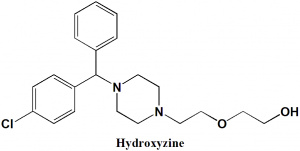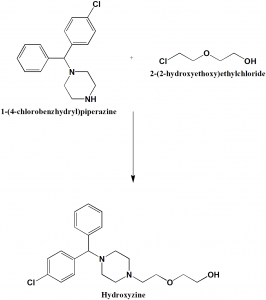HYDROXYZINE Synthesis, SAR, MCQ,Structure,Chemical Properties and Therapeutic Uses
Hydroxyzine
IUPAC nomenclature
(±)-2-(2-{4-[(4-chlorophenyl)-phenylmethyl]piperazin-1-yl}ethoxy)ethanol
Classification
- H1-receptor antihistamine
- Piperazine antihistamine
Physiochemical Properties
| S. NO. | PHYSICAL AND CHEMICAL PROPERTIES | |
| 1 | Molecular weight | 374.9 g/mol |
| 2 | Physical appearance | Solid or oil |
| 3 | Melting point | 190oC |
| 4 | Solubility | 428 mg/L in water |
| 5 | Octanol/water partition coefficient | 2.7 |
| 5 | Presence of ring | Piperazine, phenyl |
| 6 | Number of chiral centers | 1 |
Mechanism of Action
i. Hydroxyzine acts as an inverse agonist for H1 receptors.
ii. This inverse agonism is responsible for efficacy of the drug in the treatment of histaminic edema, flare and pruritus.
iii. Sedative properties of the drug allows activity as an anxiolytic.
iv. Anti-emetic properties are secondary to activity at the off-targets.
Structure Activity Relationship
Structure activity of piperizine antihistamines can be summarized as:
- These are the derivatives of ethylene diamines.
- The connecting moiety is CHN group
- Primary structural difference is nature of para aromatic ring substituent
- These are moderately potent.
- Slow onset of action
- Low incidence of drowsiness
- They also exhibit peripheral and central antimuscarinic activity.
Method of synthesis
Alkylation of 1-(4-chlorobenzhydryl)piperazine with 2-(2-hydroxyethoxy)ethylchloride gives hydroxyzine.[1]
Medicinal Uses
Hydroxyzine is used for treatment of:
- Itching
- Anxiety
- Histaminic edema
- Flare
- Pruritus
- Chronic urticaria
- Management of agitation caused due to alcohol withdrawl
- Motion sickness
- Nausea
- Vomiting
Side Effects
Side effects of Hydroxyzine are:
- Dizziness
- Blurred vision
- Dry mouth
- Constipation
- Mood changes
- Restlessness
- Hallucinations
- Tremors
- Difficulty urination
- Seizures
- Irregular heartbeats
- Fainting
- Allergic reactions
MCQs
Q.1 Correct statements from the following related with the physicochemical properties of drug Hydroxyzine are?
I. Molecular weight: 374.9 gm/mol
II. Appearance: Solid or oil
III. Melting Point:190 oC
IV. Solubility: Insoluble in water
a) I, II, III
b) I, III, IV
c) II, IV
d) I, II, III, IV
Q.2 Match the following of the drugs with their correct IUPAC names.
| i. Hydroxyzine | A. (RS)-6-(Difluoromethoxy)-2-[(3,4-dimethoxypyridin-2-yl)methylsulfinyl]-1H-benzo[d]imidazole |
| ii. Dimethindene | B. N,N-Dimethyl-2-[3-(1-pyridin-2-ylethyl)-1H-inden-2-yl]ethan-1-amine |
| iii. Doxylamine | C. (RS)-N,N-dimethyl-2-(1-phenyl-1-pyridin-2-yl-ethoxy)-ethanamine |
| iv. Pentoprazole | D. 11-(1-Methylpiperidin-4-ylidene)-6,11-dihydro-5H-benzo[5,6]cyclohepta[1,2-b]pyridine |
a) i-D, ii-B, iii-C, iv-A
b) i-A, ii-B, iii-D, iv-C
c) i-B, ii-C, iii-A, iv-D
d) i-A, ii-C, iii-D, iv-B
Q.3 Mechanism of action of drug Hydroxyzine involves?
I. Antagonist for H1 receptor
II. Inverse agonist for H1 receptor
III. Also anxiolytic activity
a) I, III
b) I, IV
c) I, II, III
d) II, III
Q.4 Correct sequence for True/false for the classification of the drug can be?
- Hydroxizine: H1-receptor antihistamine drug
- Enflurane: Sedative-hypnotics
- Tripelenamine: H1-antagonist
- Dexamethasone: Corticoids
a) TFTF
b) TTFF
c) TFTT
d) TFFT
Q.5 The connecting link in the structure of piperazine antihistamines is?
a) CHN
b) CHO
c) Acetic anhydride
d) None of the above
Q.6 Type of rings present in the structure of Hydroxyzine?
I. Phenyl
II. Piperazine
III. Piperidine
IV. Benzodiazepine
a) I, IV
b) I, II
c) II, III
d) II
Q.7 Side effect of drug Hydroxyzine is/are?
a) Constipation
b) Dry mouth
c) Tremors
d) All of the above
Participate in Online FREE GPAT TEST: CLICK HERE
Participate in Online FREE Pharmacist TEST: CLICK HERE
Participate in Online FREE Drug Inspector TEST: CLICK HERE
Participate in CSIR NET JRF Mock Test
ANSWERS
1-a
2-a
3-d
4-c
5-a
6-b
7-d
REFERENCES
[1] Vardanyan R, Hruby V. Synthesis of essential drugs. Elsevier; 2006 Mar 10.

